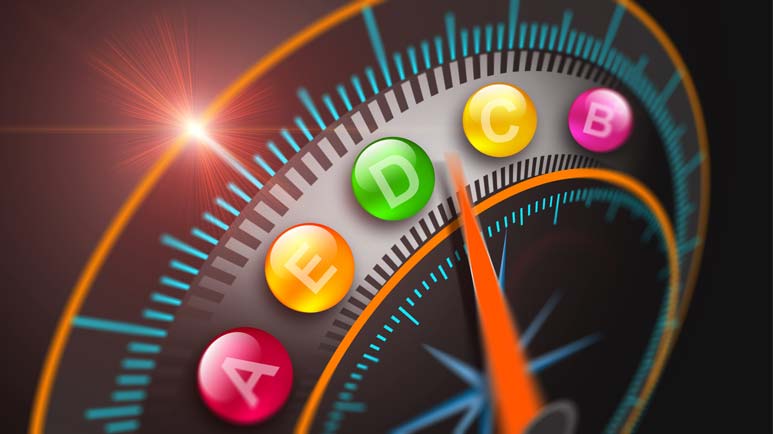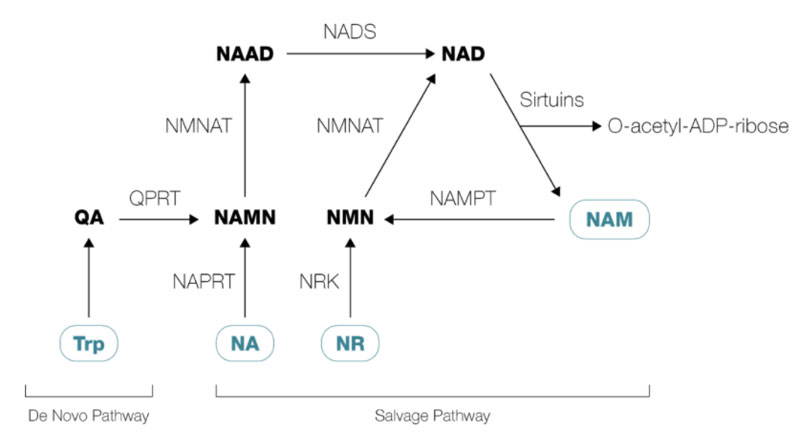NMN vs NAD+: What's the Difference?
What's the difference between NAD+ and NMN? We will cover the essentials and explain about each of these nutrients below.

NAD
NAD is derived from Nicotinamide Riboside (NR) and other NAD precursors. NR is one of the 3 main forms of Niacin (vitamin B3).NAD+ is a substrate for a number of important enzymes, including poly(ADP-ribose) polymerase (PARP) and sirtuin 1 (SIRT1), which is known as a classic longevity protein. NAD+ is also essential in metabolic processes such as creating ATP in your mitochondria. It accepts and donates electrons and is used in oxidation-reduction reactions in the mitochondrial electron transport chain.
The levels of NAD in our body determine the speed of aging process. In younger cells and tissues, the levels of NAD are higher. As a result, younger people tend to have better physical activity, cognitive function and potential for cell repair and regeneration. As we grow, the levels of NAD in our body start to decline. This is reflected in the form of slowed cognitive response, loss of memory and reduced agility.
Research suggests it may be possible to reverse mitochondrial decay with dietary supplements that increase cellular levels of a molecule called NAD (nicotinamide adenine dinucleotide).
NAD is a linchpin of energy metabolism, among other roles, and its diminishing level with age has been implicated in mitochondrial deterioration. Supplements containing nicotinamide riboside, or NR, a precursor to NAD that's found in trace amounts in milk, might be able to boost NAD levels.
The NAD story took off toward the end of 2013 with a high-profile paper by Harvard's David Sinclair and colleagues. Sinclair, recall, achieved fame in the mid-2000s for research on yeast and mice that suggested the red wine ingredient resveratrol mimics anti-aging effects of calorie restriction. This time his lab made headlines by reporting that the mitochondria in muscles of elderly mice were restored to a youthful state after just a week of injections with NMN (nicotinamide mononucleotide), a molecule that naturally occurs in cells and, like NR, boosts levels of NAD.
NAD boosters might work synergistically with supplements like resveratrol to help reinvigorate mitochondria and ward off diseases of aging. Elysium is banking on this potential synergy—its NR-containing supplement includes a resveratrol-like substance called pterostilbene (pronounced tero-STILL-bean), which is found in blueberries and grapes.
While resveratrol has hogged the anti-aging spotlight over the past decade, unsung researchers in places like Oxford, Miss., have quietly shown that pterostilbene is a kind of extra-potent version of resveratrol. The pterostilbene molecule is nearly identical to resveratrol's except for a couple of differences that make it more "bioavailable" (animal studies indicate that about four times as much ingested pterostilbene gets into the bloodstream as resveratrol). Test-tube and rodent studies also suggest that pterostilbene is more potent than resveratrol when it comes to improving brain function, warding off various kinds of cancer and preventing heart disease.
How excited should we be about all this? If I were a middle-aged mouse, I'd be ready to spend some of the nickels and dimes I'd dragged off the sidewalk to try NR supplements. Even before Sinclair's paper, researchers had shown in 2012 that when given doses of NR, mice on high-fat diets gained 60 percent less weight than they did on the same diets without NR. Further, none of the mice on NR showed signs of diabetes, and their energy levels improved. The scientists reportedly characterized NR's effects on metabolism as "nothing short of astonishing."
But the paucity of human data gives me pause. Nobel laureates notwithstanding, I plan to wait until more is known before jumping up from the supper table to run out for some NR. Besides, it probably won’t be long before more data come out given the growing buzz about NAD.
Source: https://blogs.scientificamerican.com/guest-blog/beyond-resveratrol-the-anti-aging-nad-fad/
Research suggests it may be possible to reverse mitochondrial decay with dietary supplements that increase cellular levels of a molecule called NAD (nicotinamide adenine dinucleotide).
NAD is a linchpin of energy metabolism, among other roles, and its diminishing level with age has been implicated in mitochondrial deterioration. Supplements containing nicotinamide riboside, or NR, a precursor to NAD that's found in trace amounts in milk, might be able to boost NAD levels.
The NAD story took off toward the end of 2013 with a high-profile paper by Harvard's David Sinclair and colleagues. Sinclair, recall, achieved fame in the mid-2000s for research on yeast and mice that suggested the red wine ingredient resveratrol mimics anti-aging effects of calorie restriction. This time his lab made headlines by reporting that the mitochondria in muscles of elderly mice were restored to a youthful state after just a week of injections with NMN (nicotinamide mononucleotide), a molecule that naturally occurs in cells and, like NR, boosts levels of NAD.
NAD boosters might work synergistically with supplements like resveratrol to help reinvigorate mitochondria and ward off diseases of aging. Elysium is banking on this potential synergy—its NR-containing supplement includes a resveratrol-like substance called pterostilbene (pronounced tero-STILL-bean), which is found in blueberries and grapes.
While resveratrol has hogged the anti-aging spotlight over the past decade, unsung researchers in places like Oxford, Miss., have quietly shown that pterostilbene is a kind of extra-potent version of resveratrol. The pterostilbene molecule is nearly identical to resveratrol's except for a couple of differences that make it more "bioavailable" (animal studies indicate that about four times as much ingested pterostilbene gets into the bloodstream as resveratrol). Test-tube and rodent studies also suggest that pterostilbene is more potent than resveratrol when it comes to improving brain function, warding off various kinds of cancer and preventing heart disease.
How excited should we be about all this? If I were a middle-aged mouse, I'd be ready to spend some of the nickels and dimes I'd dragged off the sidewalk to try NR supplements. Even before Sinclair's paper, researchers had shown in 2012 that when given doses of NR, mice on high-fat diets gained 60 percent less weight than they did on the same diets without NR. Further, none of the mice on NR showed signs of diabetes, and their energy levels improved. The scientists reportedly characterized NR's effects on metabolism as "nothing short of astonishing."
But the paucity of human data gives me pause. Nobel laureates notwithstanding, I plan to wait until more is known before jumping up from the supper table to run out for some NR. Besides, it probably won’t be long before more data come out given the growing buzz about NAD.
Source: https://blogs.scientificamerican.com/guest-blog/beyond-resveratrol-the-anti-aging-nad-fad/
NAD+ Helps Restore Age-Related Muscle Deterioration
As reported by Science Daily, scientists recently discovered that Alzheimer's-like protein aggregates underlie the muscle deterioration commonly seen in aging, and that nicotinamide adenine dinucleotide (NAD+) is essential for combating this condition.
Their study, published in the journal Cell Reports, showed that protein aggregates (amyloid) could be blocked by boosting the levels of NAD+, a biomolecule that is also essential for maintaining mitochondrial function.
NAD+ boosting molecules such as nicotinamide riboside (NR), nicotinamide mononucleotide (NMN), nicotinamide (a form of vitamin B3 or niacin) and nicotinic acid (niacin) have all been shown to protect against age-related muscle disease.
Their study, published in the journal Cell Reports, showed that protein aggregates (amyloid) could be blocked by boosting the levels of NAD+, a biomolecule that is also essential for maintaining mitochondrial function.
What is the difference between NAD and NAD+?
If you have done any research on aging and health recently, you have likely stumbled across the so-called anti-aging molecule, NAD. You have probably also seen it called NAD+ and maybe even as NADH. So, what is the difference, if there is any?The short answer is that there is a difference, at least between NAD and NADH. Generally speaking, when NAD is used, NAD is being talked about generally. And often when using “NAD” it is referring to the specific chemical forms of NAD, NAD+ and NADH, interchangeably.
NAD exists in two forms: NAD+ and NADH. Its ability to switch between these two forms is what allows NAD to carry out its main function—carrying electrons from one reaction to another in the process of metabolism and energy production.
As an electron carrier, NAD+ and NADH help to convert the nutrients in your food into a form of energy your cells can use.
Niacin (NA)
Niacin or the original vitamin B3 is another precursor to nicotinamide adenine dinucleotide (NAD+). There are three main forms of vitamin B3, which are dietary precursors to nicotinamide adenine dinucleotide (NAD). These are nicotinamide riboside (NR), nicotinic acid and nicotinamide; collectively referred to as vitamin B3.NR vs NMN
NR (Nicotinamide Riboside) used to be considered superior because no NMN transporter — required to get it into cells — had been detected. We now know there is such a transporter, which gives NMN the advantage as it’s also a more direct NAD+ precursor.
Most of the NAD+ precursor research is done with NR. However, as you can see from the image above, NMN converts to NAD+ whereas NR must first be converted into NMN before it can be converted into NAD+, so it makes more sense to use NMN for NAD+ augmentation.

Most of the NAD+ precursor research is done with NR. However, as you can see from the image above, NMN converts to NAD+ whereas NR must first be converted into NMN before it can be converted into NAD+, so it makes more sense to use NMN for NAD+ augmentation.
The image above also shows how niacin (NA) also finds its way to become NAD+. Niacin is also a useful supplement to use in increasing NAD+ levels. You just need to limit the dose to about 25 mg, which most is a dose low enough not to cause any flushing. Higher doses are not likely as effective as NMN and exercise in producing NAD+.
There has been few, if any, head to head research published comparing Nicotinamide MonoNucleotide (NMN) and Nicotinamide Riboside (NR).
However, Dr. Sinclair recently said he takes NMN instead of NR based on a head to head research he did that found NR did not work at all, while NMN increased the endurance in older mice such that they were able to run twice as far as those on placebo.
However, Dr. Sinclair recently said he takes NMN instead of NR based on a head to head research he did that found NR did not work at all, while NMN increased the endurance in older mice such that they were able to run twice as far as those on placebo.
NAD is a big molecule relative to vitamin B3. It's got those phosphates on there. It's got a sugar. It's got the vitamin B attached. So you've got all these components that come together to make this very complicated molecule called NAD. And when you give NMN, it contains all three components that the body needs to make NAD. If you give NR or just vitamin B3, which is an even smaller molecule, the body has to find these other components from somewhere else. So where do you get phosphate? Well, body needs it for DNA, needs it for bones. So high doses of something that requires additional phosphate makes me a little concerned...
David Sinclair was referencing this research, but unfortunately, they did not publish the results they found with NR.
Related:









Comments